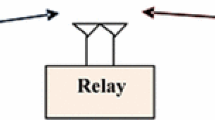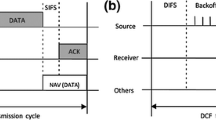Abstract
Cooperative diversity schemes can be seen as an extension of spatial diversity systems, where distributed antennas are placed in relay nodes distributed in space as compared to a single multi-antenna source or receiver in conventional spatial diversity systems. Such cooperative communication systems improve the diversity gain significantly. In this paper a cross layer optimization scheme, based on cooperative diversity along with constellation rearrangement, is proposed for minimizing energy toll and enhancing the network longevity. By utilizing a cross-layer cooperative strategy, distributive algorithms are proposed for the dependability restriction multi-hop networks. We demonstrate through simulations that the proposed cross-layer cooperative strategies along with constellation rearrangement achieve considerable energy savings and extend the network longevity significantly. Finally the proposed scheme is evaluated through NS2 simulations in terms of throughput and delay.



















Similar content being viewed by others
References
Barua, B., Abolhasan, M., & Safaei, F. (2011). On the symbol error probability of multi-hop parallel relay networks. IEEE Communications Letters, 15(7), 719–721.
Barua, B., Safaei, F., & Abolhasan, M. (2010). On the outage of multi-hop parallel relay networks. In Proceedings of IEEE vehicular technology conference, VTC-2010 fall, Ottawa, Canada, pp. 1–5. doi:10.1109/VETECF.2010.5594220
Gui, B., Dai, L., & Cimini, L. (2009). Routing strategies in multi-hop cooperative networks. IEEE Transactions on Wireless Communications, 8(2), 843–855.
Ngo, H. Q., & Larsson, E. G. (2011). Linear multi-hop amplify-and-forward relay channels: Error exponent and optimal number of hops. IEEE Transactions on Wireless Communications, 10(11), 3834–3842.
Bai, Zhiquan, Jia, Jianlan, Wang, Cheng-Xiang, & Yuan, Dongfeng. (2015). Performance analysis of SNR-based incremental hybrid decode-amplify-forward cooperative relaying protocol. IEEE Transactions on Communications, 63(6), 1–1.
Qi, Jian, Aissa, S., & Alouini, M.-S. (2014). Dual-hop amplify-and-forward cooperative relaying in the presence of Tx and Rx in-phase and quadrature-phase imbalance. IET Communications, 8(3), 287–298.
van der Meulen, E. C. (1971). Three-terminal communication channels. Advances in Applied Probability, 3(1), 120–154.
Cover, T. M., & El Gamal, A. A. (1979). Capacity theorems for the relay channel. IEEE Transactions on Information Theory, 25(5), 572–584.
Uysal, M., & Fareed, M. M. (2010). Cooperative diversity systems for wireless communication. In I. Woungang, S. Misra, & S. C. Misra (Eds.), Handbook on information and coding theory. Singapore: World Scientific.
Barua, B., Ngo, H., & Shin, H. (2008). On the SEP of cooperative diversity with opportunistic relaying. IEEE Communications Letters, 12(10), 727–729.
da Costa, D., & Aissa, S. (2009). End-to-end performance of dual-hop semi blind relaying systems with partial relay selection. IEEE Transactions on Wireless Communications, 8(8), 4306–4315.
Khormuji, M., & Skoglund, M. (2011). Capacity achieving instantaneous relaying. IEEE International Symposium on Wireless Communication Systems (ISWCS), pp. 814–818.
Quek, T. Q. S., Win, M. Z., & Chiani, M. (2010). Robust power allocation algorithms for wireless relay networks. IEEE Transactions on Communications, 58(7), 1931–1938.
Izi, Y. A., & Falahati, A. (2012). Amplify-forward relaying for multiple-antenna multiple relay networks under individual power constraint at each relay. EURASIP Journal on Wireless Communications and Networking, 2012(1), 1.
Ding, H., Ge, J., da Costa, D. B., & Jiang, Z. (2010). Diversity and coding gains of fixed-gain amplify-and-forward with partial relay selection in Nakagami-m fading. IEEE Communications Letters, 14(8), 734–736.
Ding, Zhiguo, Leung, Kin K., Goeckel, Dennis L., & Towsley, Don. (2011). Opportunistic relaying for secrecy communications: Cooperative jamming vs. relay chatting. IEEE Transactions on Wireless Communications, 10(6), 1725–1729.
Krikidis, I., Thompson, J., McLaughlin, S., & Goertz, N. (2008). Amplify and- forward with partial relay selection. IEEE Communications Letters, 12(4), 235–237.
Ahmed, I., Nasri, A., Michalopoulos, D. S., Schober, R., & Mallik, R. K. (2012). Relay subset selection and fair power allocation for best and partial relay selection in generic noise and interference. IEEE Transactions on Wireless Communications, 11(5), 1828–1839.
Bahadori-Jahromi, Farhad, Pourmina, Mohammad Ali, & Masnadi-Shirazi, Mohammad Ali. (2013). Concatenation of space-time block codes with constellation rearrangement. Arabian Journal for Science and Engineering, 38(10), 2703–2712.
Bahadori-Jahromi, Farhad, Pourmina, Mohammad Ali, & Masnadi-Shirazi, Mohammad Ali. (2014). Performance of cooperative spatial multiplexing SISO/MIMO communication systems with constellation rearrangement technique. Arabian Journal for Science and Engineering, 39(2), 1067–1078.
Chen, Y., Qin, F., Xing, Y., & Buranapanichkit, D. (2014). Cross-layer optimization scheme using cooperative diversity for reliable data transfer in wireless sensor networks. International Journal of Distributed Sensor Networks, 2014. doi:10.1155/2014/714090.
Goldsmith, A. (2005). Wireless communications. Cambridge: Cambridge University Press.
Tannenbaum, A. S. (2003). Computer networks (4th ed.). Upper Saddle River: Prentice Hall.
Wu, D., Cai, Y., Zhou, L., & Wang, J. (2012). A cooperative communication scheme based on coalition formation game in clustered wireless sensor networks. IEEE Transactions on Wireless Communications, 11(3), 1190–1200.
Habibi, J., Ghrayeb, A., & Aghdam, A. (2013). Energy-efficient cooperative routing in wireless sensor networks: a mixed-integer optimization framework and explicit solution. IEEE Transactions on Communications, 61(8), 3424–3437.
Moore, E. F. (1957). The shortest path through a maze. In Proceedings of the international symposium on theory of switching, pp. 285–292.
Ibrahim, A. S., Han, Z., & Liu, K. J. R. (2008). Distributed energy efficient cooperative routing in wireless networks. IEEE Transactions on Wireless Communications, 7(10), 3930–3941.
Kwon, Hojoong, Kim, Tae Hyun, Choi, Sunghyun, & Lee, Byeong Gi. (2006). A cross-layer strategy for energy-efficient reliable delivery in wireless sensor networks. IEEE Transactions on Wireless Communications, 5(12), 3689–3699.
Rhee, I., Warrier, A., Aia, M., Min, J., & Sichitiu, M. L. (2008). Z-MAC: a hybrid mac for wireless sensor networks. IEEE/ACM Transactions on Networking, 16(3), 511–524.
Cui, S., Madan, R., Goldsmith, A. J., & Lall, S. (2007). Cross-layer energy and delay optimization in small-scale sensor networks. IEEE Transactions on Wireless Communications, 6(10), 3688–3699.
Shi, L., & Fapojuwo, A. O. (2010). TDMA scheduling with optimized energy efficiency and minimum delay in clustered wireless sensor networks. IEEE Transactions on Mobile Computing, 9(7), 927–940.
Rudafshani, M., Datta, S. (2007) Localization in wireless sensor networks. In: ACM/IEEE IPSN’07, Cambridge, Massachusetts, USA, April 2007.
Author information
Authors and Affiliations
Corresponding author
Appendix
Appendix
1.1 Proof of (40)
Consider Specified block in Fig. 2; the probability that the source m transmits only, denoted by \(\Pr (\psi )\), is computed as
where the term \(1 - \Pr \left( {I_{m,n} \le R^{CT} } \right)\) denotes the event when the sender-receiver channel is not in failure, while the other term corresponds to the event when both the sender receiver and the sender-relay channels are in failure. The probability that the relay collaborates with the source is as follow:
Thus, the average transmission rate of the cooperative transmission mode can be computed as
where \(R^{CT}\) denotes the transmission rate if the sender is sending alone in one time slot, and \(R^{CT} /2\) denotes the transmission rate if the relay collaborates with the sender in the following time slot. Since
Thus
Using (39)
There is
where
Thus, we have
where L is the number of hops of the route. Thus
So to ensure the fulfillment of desired total transmission rate \(R^{CT}\) should be at least
Consider the consumed power of the cooperative block.
Using (39), the total transmission power of the route is
For the multiple-relay cooperation mode applying (29), there is
and the total transmission power is
Equations (39) and (76) show that the value of \(R^{CT}\) has a considerable effect on the transmission power. To minimize total transmission power, a minimum \(R^{CT}\) should be used to fulfill the desired total transmission data rate in (1).
Rights and permissions
About this article
Cite this article
Bahadori-Jahromi, F. Joint design of physical and MAC layer by applying the constellation rearrangement technique in cooperative multi-hop networks. Wireless Netw 23, 2361–2378 (2017). https://doi.org/10.1007/s11276-016-1292-1
Published:
Issue Date:
DOI: https://doi.org/10.1007/s11276-016-1292-1




